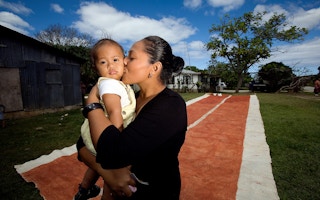Over the next few months, the 12,000 employees based at Apple’s headquarters in Cupertino, California will complete their move to an extravagant new campus. The “spaceship,” covering 2.8 million square feet, includes a two-story yoga studio, running paths, and even revolutionary pizza boxes that keep slices crisp. One thing it does not have, however, is daycare.
To continue reading, subscribe to Eco‑Business.
There's something for everyone. We offer a range of subscription plans.
- Access our stories and receive our Insights Weekly newsletter with the free EB Member plan.
- Unlock unlimited access to our content and archive with EB Circle.
- Publish your content with EB Premium.
When it comes to ignoring the importance of childcare for working parents, Apple is far from unique. And that omission places a powerful drag on parents’ ability to achieve their economic potential, with women suffering the most.
Worldwide, women carry out twice as much unpaid domestic and care work – including raising children, caring for sick or elderly family members, and managing the household – as men do. In Mexico, India, and Turkey, women do three times more care work than men.
This “gender chore gap” limits women’s choices, as it impedes their ability to obtain formal education, secure good jobs, and achieve equal pay. Indeed, though women around the world actually work more than men in total (including both paid and unpaid work), they earn one quarter less, on average, hold only one quarter of executive positions in the private sector, and occupy less than one quarter of all seats in national parliaments.
Only half of working-age women worldwide are in the paid labor force, compared to more than three quarters of men.
This situation is slowly beginning to change. Unpaid household and care work is gradually shedding its reputation as “women’s work,” and men today are assuming more household responsibilities than their fathers and grandfathers did.
Some countries, particularly in Europe, are revising traditional leave policies so that parents can choose how to allocate time off after the birth of a child.
More broadly, the value of unpaid household and care work – not just for children and family members, but also for the long-term health of societies and economies – is increasingly being recognized. Efforts to measure the contribution of care work to national economies have produced estimates ranging from 20 per cent to 60 per cent of GDP.
In 2015, United Nations member states adopted the Sustainable Development Goals (SDGs), which call for recognizing, reducing, and redistributing unpaid care work – a measure long proposed by feminist economists and gender-equality advocates. The question now is what can actually be done to meet this objective.
The responsibility will lie, first and foremost, with governments. After all, while businesses or neighborhood associations may offer childcare options to working parents, costs and quality vary widely. Government action is needed to ensure that care services cover all who need them – from preschool children to the sick, the disabled, and the elderly – and that they are universally accessible and affordable.
“
As populations grow and age, the care sector will only increase in importance. Adapting to these new circumstances now will give countries a considerable advantage, as it bolsters women’s rights and freedoms, generates jobs, and make societies more equal.
Beyond services, however, achieving the SDGs’ targets will require policy change. Most important, governments must establish requirements for parental and family leave programs. Together with private companies, they can also provide monetary incentives for men and women to share household and care work more equally.
Such policies have proved effective not only in Northern Europe – the most commonly cited model – but also in Eastern European countries like Lithuania, Estonia, and even Hungary, demonstrating that they can be applied anywhere.
At a time when many governments, particularly in the developing world, are faced with severe fiscal constraints, such interventions may seem farfetched. But spending on the care sector should be viewed as an investment, not a cost.
A recent study in Turkey showed that one dollar of public money invested in the care sector could create 2.5 times as many jobs as a dollar invested in the construction industry. More than half of those jobs – decent jobs that could raise incomes and living standards, particularly for poor households – would go to women.
International institutions can play an important role in helping governments to seize the opportunities presented by investment in the care sector. In the former Yugoslav Republic of Macedonia, the United Nations Development Programme undertook an initiative that helped women who had mostly worked at home their entire lives to find jobs in the care sector, enabling them to make use of their skills, by caring for children and for young adults with disabilities, while earning an income.
As populations grow and age, the care sector will only increase in importance. Adapting to these new circumstances now will give countries a considerable advantage, as it bolsters women’s rights and freedoms, generates jobs, and make societies more equal. So what are we waiting for?
Bharati Sadasivam is the United Nations Development Programme’s regional gender adviser for Eastern Europe and Central Asia.
Copyright: Project Syndicate, 2017.
www.project-syndicate.org











